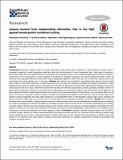| dc.contributor.author | Zolnikov, Tara Rava | |
| dc.contributor.author | Smet, Eefje | |
| dc.contributor.author | Nguura, Peter Ngatia | |
| dc.contributor.author | Leshore, Lepantas Charles | |
| dc.contributor.author | Have, Steven ten | |
| dc.contributor.editor | Graamans, Ernst Patrick | |
| dc.date.accessioned | 2022-01-26T21:20:49Z | |
| dc.date.available | 2022-01-26T21:20:49Z | |
| dc.date.issued | 2019-03-04 | |
| dc.identifier.citation | Lessons learned from implementing alternative rites in the fight against female genital mutilation/cutting | en_US |
| dc.identifier.issn | 937-8688 | |
| dc.identifier.uri | https://repository.amref.ac.ke/handle/123456789/537 | |
| dc.description | © Ernst Patrick Graamans et al. The Pan African Medical Journal - ISSN 1937-8688. This is an Open Access article distributed under the terms of the Creative Commons Attribution License (http://creativecommons.org/licenses/by/2.0), which permits unrestricted use, distribution, and reproduction in any medium, provided the original work is properly cited. | en_US |
| dc.description.abstract | Introduction: historically, programs aimed at making communities abolish female genital mutilation or cutting (FGM/C) consisted mainly of awareness campaigns on sexual reproductive health and rights and the enforcement of newly implemented laws. These types of programs or interventions appear to be only partially effective and sometimes yield unintended results, such as actually strengthening commitment to FGM/C or transforming it into a secret practice. A newer approach to change that is intended to account for the cultural meanings ascribed to FGM/C are alternative rites of passage (ARP). Amref Health Africa started adopting this approach in 2007. Since then, by a trial-and-error process lessons have been learned, that will be reflected upon in this paper. Methods: desk research was conducted on organizational data regarding all Amref Health Africa's efforts to end FGM/C. Ninety-four in-depth formal interviews were held with members from Maasai and Samburu communities in Kenya targeted through maximum variation sampling. And participant observation of significative events as well as daily pastimes took place during school holiday season at the end of 2016. Furthermore extensive informal talks were held with project donors, activists, journalists, members of other non-governmental organizations, members of community services organizations, local government officials, high-ranking Dutch and US diplomats and senior members of the Anti-Female Genital Mutilation Board, which is part of the Kenyan Ministry of Public Service, Youth and Gender Affairs. On the basis of these data a framework on different positions on FGM/C was developed and published in early 2018. By reviewing the data again from a particular change management and public health perspective, by peer-debriefing within a multi-disciplinary research team and by explicating the lessons learned this paper adds to an overview that is of crucial importance to practitioners working to end FGM/C. Results: risk of exclusion, perceived loss of cultural identity, changing meanings ascribed to cultural practices, lack of precise knowledge about subjective (sexual) experience and negative stereotyping are reasons not to adhere to anti-FGM/C programs. Areas of concern are the role confusion with following-up on policing, perceived outsider interference and the intended prolonging of the transition phase into womanhood not being explicated and embedded with ARP. Aspects to enhance to lever change more effectively are education and school curriculum development, male involvement, new stylization of love relationships, monitoring and evaluation and inclusive aspects of religion. Conclusion: changing a culturally embedded practice such as FGM/C is inherently complex. Because the cultural meanings ascribed to this practice are also evolving, any intervention that is effective at present might become superfluous in the future. A holy grail approach to change simply does not exist. Change needs to be levered in a variety of ways while working on the alignment of all these efforts by regular and thorough quantitative and qualitative assessments of effects and side-effects and reflections on lessons learned | en_US |
| dc.description.sponsorship | TEN HAVE Change Management, VvAA (Vereniging van Artsen Automobilisten), VU University Amsterdam and Amref Health Africa | en_US |
| dc.language.iso | en | en_US |
| dc.publisher | CrossMark | en_US |
| dc.subject | Female genital cutting | en_US |
| dc.subject | Non-adherence | en_US |
| dc.subject | Rites of passage | en_US |
| dc.title | Lessons Learned from Implementing Alternative Rites in the Fight Against Female Genital Mutilation_Cutting | en_US |
| dc.type | Article, Journal | en_US |

